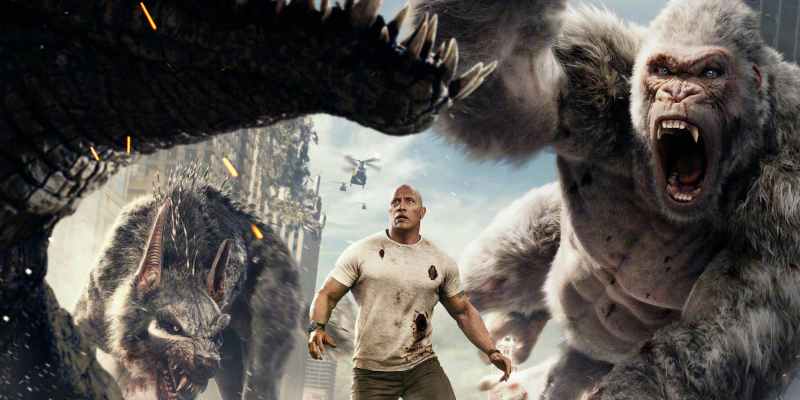“Rampage” is a 100-million dollar adaptation of a 1980s arcade cabinet. When was this film made? Judging by the quality of the CGI, about 2006, placing this 2018 movie about on par with Peter Jackson’s “King Kong.” Why was this film made? Warner Brothers acquired arcade developer Midway for 33 million dollars and apparently didn’t want that investment to go to waste. How was this film made? By throwing The Rock at the screen and hoping that his raw star power will reverse Hollywood’s idiotic decision to release yet another doomed video-game movie.
“Rampage” is about a giant ape, a giant wolf and a giant crocodile (or alligator, more accurately speaking) that rip apart buildings and squash extras, alongside the muscular hero and beautiful (and “empowered,” because despite the fact that she requires repeated saving, we’re told that she has a PhD from Stanford) sidekick who save the day. Two corporate villains sit in their high-rise lair full of unnecessarily large TV screens, scheming to lure these genetically modified beasts into the heart of Chicago so that they can administer the anti-monster antidote (before, of course, they inexplicably try to stop the two heroes from doing exactly the same thing). Military men with gruff voices decide that the best solution is to blow everything up, and Neegan from “The Walking Dead” shows up as a well-dressed cowboy that always sounds like he’s halfway through a yawn. And at the end of the day, The Rock isn’t the “Davis the primatologist” written in the script, he’s simply The Rock, tattoos and all, playing the exact same character he’s played in every other movie.
At some point, a plot becomes so generic and so predictable, with characters so lifeless and unlikable, that the audience cannot help but ask why the writers bothered in the first place. The answer, of course, is that movies have to be two hours long, and filling all that time with the special effects we actually want to see costs money. There is some feeble attempt to create some semblance of heart by establishing a relationship between The Rock and George the massive gorilla (an albino, because in Hollywood even the animals have to be whitewashed), and though the single scene in which they meaningfully interact is surprisingly charming, it’s hardly enough to make us care about George any more than we do about the other dumb animals. Yet, despite the laughable premise, despite the pointless plot, “Rampage” takes itself much too seriously. The writers have simultaneously tried to integrate not one but two “tragic backstories” into a script that also contains the words “The wolf can fly!”
Even when “Rampage” gets down to blockbuster business, when its behemoths converge onto downtown Chicago for the scene that everyone bought their ticket to see, it falls harder than a drunk monkey from a tree. Kudos to director Brad Peyton for somehow making an extended battle with three massive animals mind-numbingly boring, neglecting all semblance of coherent fight choreography or flow. The best blockbuster action scenes evolve their pageantry with new, more imaginative ideas over time, building the spectacle along with the excitement. “Rampage’s” finale, though, repeats the concept of “animal hits thing, thing goes boom” ad nauseam for more than half an hour.
At the end of the day, stupidity in movies can be, and often is, a value in-and-of-itself. “Pacific Rim,” “Kingsman: The Secret Service” and “Hot Fuzz” represent some of the most consistently fun and thrilling silver-screen experiences of the past decade. But what Peyton, Warner Brothers and everyone else in “Rampage’s” credits don’t seem to understand is that even stupidity requires a deceptively intelligent hand and an aloof tongue-in-cheek attitude toward your own work. “Rampage,” however, has no semblance of subtlety or self-awareness, and is ultimately as dumb as its animals.
It’s perhaps tragic that the filmmakers couldn’t grasp this while the original 1986 arcade game could. “Rampage” the game cabinet has no semblance of unnecessary plot, involves cartoonish characters with bulging eyes, and, in perfectly silly fashion, occasionally reverts its monsters into small nude pixelated men who shuffle offscreen. Do yourself a favor: take the money you otherwise would have spent on “Rampage” the movie, exchange it for quarters and head to the nearest arcade. Punching up buildings with a greasy joystick will give you far more joy than this deadening, dull and depressingly incompetent blemish of a film ever could.
Contact Noah Howard at noah364 ‘at’ stanford.edu.
